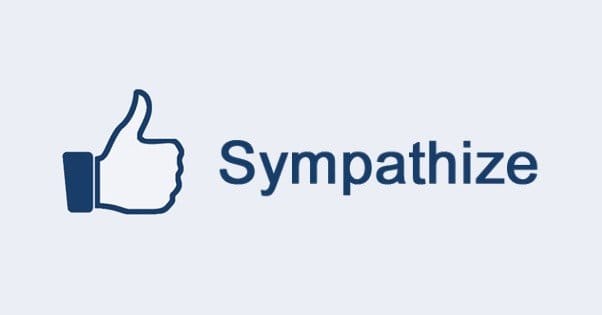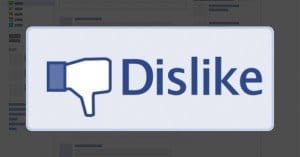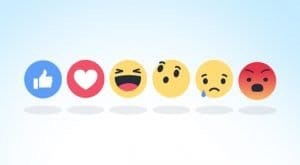 Written by ContentPowered.com
Written by ContentPowered.com
In a recent press event, Mark Zuckerberg mentioned something quite interesting for the Facebook world. He mentioned that for years there has been pressure to build some form of “dislike” button as a counterpart to the like button. Further, he mentioned that not only have they been building such a button internally, and that it is almost ready to be released for limited testing on the live platform. It’s expected that the button will begin testing as early as next month.
What Would a Dislike Button Be?
Now, there’s plenty of precedent for a dislike button throughout the internet. Just take a look at Reddit. On Reddit, every post is able to be voted up or voted down. This would be the equivalent of a like or a dislike.
Reddit also has a sorting algorithm to filter some posts to the top while others are sorted down lower. It’s not chronological. In fact, it’s far from it; in long, established conversations, new replies are often lost. Reddit’s method of posting really doesn’t make a lot of sense, all things considered. It’s a hierarchal tree, with each reply capable of starting a tree of other replies beneath it. As such, lengthy branches of replies tend to get a lot more exposure, and rise to the top. Meanwhile, new – potentially valuable – replies are filtered lower due to less visibility.
Reddit’s voting system has a problem as well. Namely, it’s not uncommon for new valuable posts to be downvoted into invisibility out of spite for the person posting, out of disagreement with the content, or simply out of some desire to troll a sub. In a purely chronological discussion format, like a web forum, it’s much cleaner and easier to keep track of replies and information. It’s also much more difficult for a few users to shut down dissenting opinions or “guide” the discussion through their votes.
That’s a digression, but it’s something to keep in mind for a point I bring up later. Right now, we’re talking about Facebook. As it stands, Facebook has a lot of means of positive interaction and very few means of negative interaction.
What I mean by this relates to EdgeRank, the algorithm Facebook uses to determine who sees posts and when. Any form of engagement will increase the EdgeRank ranking between a person and a page, or between two people. Engagement in this case can include clicking to view their profile or page, liking the page or clicking to follow them and receive notifications, liking any of their posts, commenting on them, sharing them, or clicking links in those posts.
Conversely, you don’t have much that puts a negative pressure on EdgeRank rankings. Inactivity is the biggest one; ignoring posts, ignoring the page, means Facebook figures you’re less likely to want to see what that page has to say. There are some manual actions a user can take to decrease EdgeRank, such as unliking a page or reporting that page for some rules violation. Hiding posts also counts.
There’s a good reason for this. Facebook doesn’t want their platform to become a hive of negativity, any more than it already is. They also don’t want businesses to be able to tank their competition by spamming negative forms of interaction. Massed negative reports would count, but are difficult to come by, and will be disregarded if the report isn’t accurate.
A dislike button, in a hypothetical anti-like function, would be a form of spammable negative engagement. As such, it’s unlikely to exist in that form. Indeed, Zuckerberg clarified that what they’re building isn’t so much a dislike button, as it is a sympathy button.
When is a Dislike Not a Dislike?
If you read a transcript of what Zuckerberg had to say, you’ll see that what he is attempting to design is very much not an anti-like dislike button. In fact, he is intentionally avoiding falling into the trap that so many vote-focused content sites like Reddit, Imgur, 9Gag, or a host of others have fallen into.
EdgeRank is already a non-chronological form of sorting what content should be seen, but it’s not as reliant on votes as something like Reddit. It does, in fact, include a chronological element. EdgeRank factors in time, and makes older posts have less weight, to encourage filtering through newer content.
Including a “downvote” button would throw all of EdgeRank into chaos, unless it was virtually valueless as a negative form of engagement.
That’s why Zuckerberg isn’t making a dislike button, he’s making a sympathy button. Have you ever seen a post from a friend that talked about a negative event in their life? They broke up with their boyfriend, they had a death in the family, their dog ran away? These are the kind of everyday negative events that you might want to express sympathy for.
In fact, many people do express sympathy. Some people will like the post, but go on to clarify that their like is meant as support, not as some sort of visceral satisfaction in the misfortune of others. The like button is meant for liking, not for schadenfreude.
The dislike button that Facebook is proposing is more of a sympathy button, and it is almost guaranteed to not include the text “dislike” anywhere on it. It’s going to be a “I’m sorry” button, or a sympathy button, or an empathy button.
The question remains, how will Facebook implement the button? Few expect it to be an always-available option for every post. There’s no reason for a bit of exciting news to have a sympathy button attached, right?
Limits on Context Sensitivity
Facebook’s need to test the button, to me, indicates that they have a system that they need to test that has more detail than a simple ever-present button or a toggleable option when you post. This could be related to EdgeRank, but I don’t think so. A sympathy button wouldn’t be a negative interaction with EdgeRank. You don’t say “sorry for your loss” and then want to never see that person again. That’s not how sympathy works, and worse, it could lead to a lot of problems for the people suffering from that loss.
In an extreme example, imagine someone who is on the border of suicidal. They have a negative life event, and post about it on Facebook. Their friends express sympathy, though the button, which puts negative EdgeRank pressure on them. Now those friends see fewer posts from the suicidal person in the future, which leads them to feel further isolated and alone. This could dramatically increase their risk of suicide.
Granted, that would be an edge case, but it won’t happen precisely because Facebook isn’t going to make their sympathy button into a negative form of engagement.
What Facebook is much more likely to be testing is the method that causes the button to be visible. It’s very likely that they will have some sort of context sensitive system that will look for key words in posts or key events. Some examples:
- A post that uses the phrase “passed away” is almost always going to be about someone important dying, and will likely trigger the button.
- A relationship status changing from “in a relationship with” to “single” is going to generate a story, and that story will typically be negative. This is another opportunity to trigger the button.
I doubt that there will be a way to add the button manually, though I do suspect that some people will reverse-engineer the phrases that trigger it and figure out how to work those phrases into messages that will trigger the button out of context. Some will use this for humor, some will use it accidentally, and some might attempt to use it for marketing.
In the case that you’re able to manually tell the button to appear, though, I have a few ideas for how you might use it as a business.
Using a Sympathy Button to Acknowledge Flaws
Say you have a popular product, and you’ve run out of stock for that product and won’t be able to restore your stock in a timely fashion. When you make such a product announcement, you might be able to trigger the button by saying something like “we are sorry to announce” that your product is out of stock. You can then use the sympathy button as a way to gauge interest in the restock, as well as spur on conversation about the product and any updates or upgrades users might be looking for in it.
“We are sorry to announce that our supplies of Amazing Product X are out of stock. We’re working hard to stock more, but in the mean time, tell us what you love about it!”
You can also use the opportunity to create a mailing list for people to be notified when the item is back in stock. Just try not to do too much with a single post.
Using a Sympathy Button to Mourn a Loss
You can, as a business, always use the sympathy button in the way it is initially intended to be used. Sometimes your business loses someone important to it, like a founder, CEO, or critical team member. You can report this issue to the public if it’s appropriate to do so. It doesn’t have to be a death; it could simply be that the person in question is leaving the company for other opportunities.
You can expand this for broader industry-wide applications. If a noteworthy influencer passed away, you can post about it and use the sympathy button as an additional bit of post engagement. This typically would happen in the technology sector, where someone influential passes, such as one of the inventors of a critical technology, or a creative member of the industry, like when Nintendo’s CEO passed away recently.
When reporting on this news, you gain several marketing advantages, though it’s somewhat macabre to think of it in such practical terms. You gain prominence as someone posting a newsworthy article that is sure to be shared, plus the sympathy expressions will give you additional EdgeRank benefit with the people who use them.
Plus, it’s not as if you’re being coldly calculating with it. You’re just reporting on the sad news, and you’re legitimately sympathetic. It just happens to also be beneficial for you to do so.
Using a Sympathy Button to Help with Current Events
There’s always something going on with current events that could be the trigger for some sympathy, and it would work in much the same way as any other news reporting on a negative event. When you report on a negative event you gain benefit from being one of the people reporting it. It’s just how Facebook works. People share your posts, people discuss the event on your posts, and it all benefits you in some minor way.
The sympathy button simply helps act as a catalyst for more discussion. It’s also a low-investment form of engagement.
One of the biggest problems with engagement on Facebook is how hard it is to get people to do it. A like is easy, because it’s a tiny passing investment of attention, but it doesn’t need to have much thought or emotion behind it. It’s much easier to get than a comment, because it’s like a ready-made thought. The user doesn’t need to put thought into the words they want to type; they can just click a button to express the appreciation for the post.
A sympathy button will work in much the same way; a ready made thought, an easy piece of engagement, something users don’t have to think hard about before they express. I imagine that sympathy expressions will be much more common than comments, but perhaps not as common as likes. It will be more or less mutually exclusive with likes; people don’t necessarily want to express both emotions at the same time. In some situations people can click both and mean it, but not in general.
The Thought of Buying Sympathy
There’s a thriving trade online with Facebook Likes, so will that extend to sympathy button clicks?
I don’t think it will. The button is too context sensitive, and it’s not valuable enough for general use. You’re not going to want to buy sympathy for yourself, because it just looks cheap and malicious if it’s discovered, which won’t be hard. It doesn’t benefit you in the way page likes benefit you, and it would only increase your EdgeRank with the users that express sympathy.
Conversely, because it’s incredibly unlikely that the sympathy button would be tied to negative EdgeRank, it won’t make sense to buy sympathy for competitors. You won’t be able to tank their EdgeRank, nor will you be able to hurt them by doing so. Maybe you could frame them for buying sympathy themselves, but what’s the point? It’s so minor it becomes a waste of money.
Don’t get me wrong, I’m sure someone, somewhere will sell sympathy. I just don’t think it will do much to buy it, one way or another.
Sympathy in Facebook Ads
Finally, as a business, there’s always the question of Facebook ads. I don’t think, though, that the sympathy button will have much of a place with Facebook ads. You don’t generally buy a promoted post for a negative announcement. You don’t want to promote a post about an item being out of stock. It wont’ show up in sidebar ads. I frankly don’t see a place for it.
Besides; Facebook ads work best with positive emotions powering them. What good is it to post something that pulls in sympathy, when all you get from it is less engagement than you would from an upbeat post?




